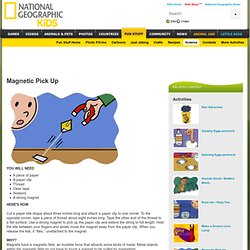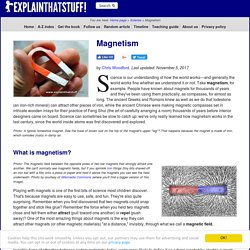

Forces and Magnets Interactive Games and Activities. Lodestones and Making Magnets" Many of today's electronic devices require magnets to function.

This reliance on magnets is relatively recent, primarily because most modern devices require magnets that are stronger than the ones found in nature. Lodestone, a form of magnetite, is the strongest naturally-occurring magnet. It can attract small objects, like paper clips and staples. By the 12th century, people had discovered that they could use lodestone to magnetize pieces of iron, creating a compass. Repeatedly rubbing lodestone along an iron needle in one direction magnetized the needle. A compass needle isn't nearly as strong as many of the permanent magnets used today. In magnets, on the other hand, most or all of the magnetic domains point in the same direction. This explains why breaking a magnet in half creates two smaller magnets with north and south poles. Magnetic Pick Up. A piece of paper A paper clip Thread Clear tape Scissors A strong magnet Cut a paper kite shape about three inches long and attach a paper clip to one corner.

To the opposite corner, tape a piece of thread about eight inches long. Tape the other end of the thread to a flat surface. Use a strong magnet to pick up the paper clip and extend the string to full length. Hold the kite between your fingers and slowly move the magnet away from the paper clip. Magnets have a magnetic field, an invisible force that attracts some kinds of metal. Text by NGS Staff Illustration by David Bamundo. Magnet Man - Cool Experiments with Magnets. Cool Experiments with Magnets This web site is devoted to magnetism and the cool experiments you can do with permanent magnets and electro-magnets.

Some of the experiments are very basic - things you've done since third grade. Others are unique - perhaps you hadn't thought of doing some of these before, or had difficulty in trying to set them up. Lists of the materials needed for the demonstrations, directions on how to assemble them, instructions on how to show them, and notes on how they work are all here for you. Also shown are several cool magnetic toys you can buy. Have fun with hands-on experiments! Rick Hoadley(For other cool toys and puzzles, check this out!) Last updated: 26 Feb 2017.
. , that means that at the underlined link there is some kind of experiment you can buy or build which will help you learn about the world of magnetism. Safety Considerations IMPORTANT! How magnetism works - a simple introduction. By Chris Woodford.

Last updated: November 5, 2017. Science is our understanding of how the world works—and generally the world works fine whether we understand it or not. Take magnetism, for example. People have known about magnets for thousands of years and they've been using them practically, as compasses, for almost as long. The ancient Greeks and Romans knew as well as we do that lodestone (an iron-rich mineral) can attract other pieces of iron, while the ancient Chinese were making magnetic compasses set in intricate wooden inlays for their practice of Feng Shui (the art of carefully arranging a room) thousands of years before interior designers came on board.
Photo: A typical horseshoe magnet. What is magnetism? Photo: The magnetic field between the opposite poles of two bar magnets that strongly attract one another. Playing with magnets is one of the first bits of science most children discover. To ancient people, magnetism must have seemed like magic. What use are magnets?